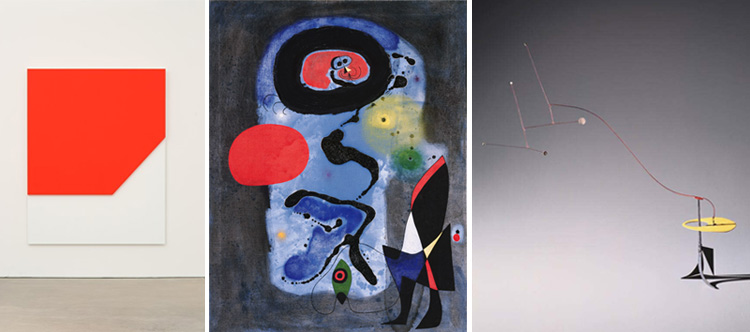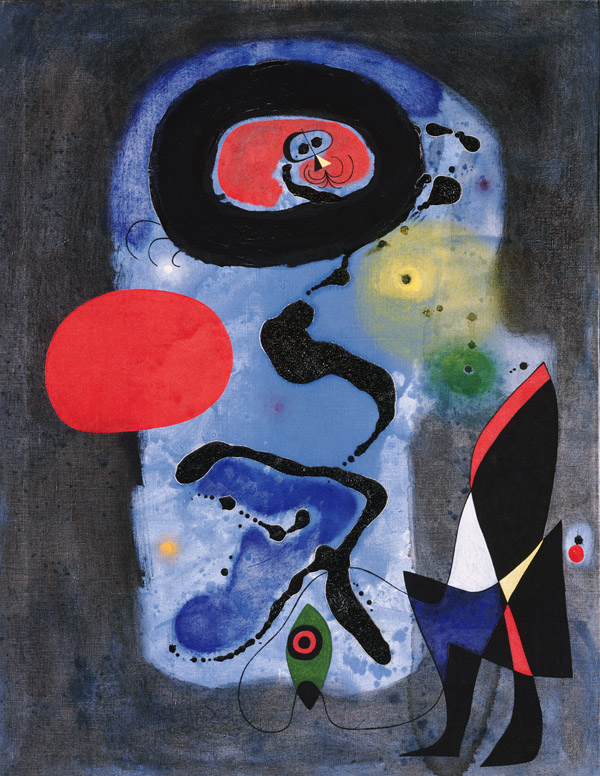For a recent Phillips after 5 collaboration with Arena Stage, we wanted to create a game for our guests that would bridge visual arts and dramatic literature. We started with an old parlor game embraced by the surrealists known as the exquisite corpse, in which a group takes turns drawing or writing a passage on a piece of paper, then folding the paper to conceal all but a glimpse of their creation, and passing it on to the next participant. At the end, a monstrous collective work is revealed.
During Phillips after 5, we placed a notebook in the gallery where Morris Louis’s Seal is on view. Simple instructions invited passersby to use the painting as inspiration and add a line or two to an unfolding drama. Today we publish the results–complete with angst, loneliness, water, sky, a ride on the Titanic, and a penguin’s perspective–here and on Arena Stage’s Stage Banter blog.
Midnight. Brisk. Quiet. Something is unknown. Enter CHASE, BELLE, and SHADOW.
BELLE: There’s something behind the curtains. What is it?
SHADOW: It moves like a racehorse. Did you see it?
CHASE: I don’t think we should watch it. It doesn’t belong here.
BELLE: I’m not sure what’s behind there, but someone should look.
SHADOW: Darkness is madness and hides the fear. The pain.
CHASE: I’m not afraid to cry. Or to try. Don’t be afraid. It’s only a dream.
BELLE: If it’s a dream then do not wake me. I’m floating, silently, wearing lace and singing a tune. A sad lament . . .
SHADOW: Wake up! A storm is near. Darkness looms. There’s no light in shadow. Deep sleep and dreaming . . .
CHASE: In my dream, curtains part—and then, a soft, smooth piece of sealskin, covering me, keeping me dry from any storm.
BELLE: You were lying so quietly next to me, and then I heard you shout. You were frightened by something or someone in your dream, it seems.
SHADOW: Death comes in many guises. I will enter softly when the time is right. Meanwhile rise up and face the stormy day ahead. Who knows what you will find. Take the boat around the bay and see me there.
BELLE: I have no interest in visiting your home—I barely can tolerate you here in a neutral setting.
CHASE: Belle! Why so harsh? Shadow’s just being polite. Besides, a boat ride across the bay is quite lovely, though at this time of day not as inviting.
SHADOW: Chase, you needn’t defend me. I’ve done nothing to offend Belle so. A trip to my home could help us all understand what we saw earlier this evening.
BELLE: We saw nothing! That was just the light of the stars playing against the leaves in that stand of trees. Everything is as it should be.
CHASE: I don’t get it. What do you mean?
BELLE: I mean isn’t it romantic the way the colors remind me of nature? They’re wet—dripping with meaning.
SHADOW: And yet it’s as if they are speaking in tongues, a different language to each observer.
CHASE: How is it that you see mere shadows, while I recognize only tangible objects?
BELLE: Ugh, I hate it when you talk in the abstract.
SHADOW: My name is Shadow. I don’t think that’s very abstract.
BELLE: (pause) I hate you two. I’m leaving.
SHADOW: Suits me just fine!
BELLE: Don’t be so glib! Our very future is at stake! You never take anything seriously. It’s like you’re swimming through life.
CHASE: Maybe that’s all he’s capable of. A rootless existence, ebbing and flowing. No substance. (To Shadow) You should be ashamed.
SHADOW: I suppose I should be like you instead? Dull as dirt, happily toiling away at the grindstone, never realizing you’re grinding yourself up in the process. There is so much you don’t know.
CHASE: What could you possibly teach me? You think you’re profound when really, you don’t even know who you are. It must hurt, being cut adrift.
BELLE: Don’t you understand the beauty of the midnight quiet. When what is known becomes unknown.
CHASE: You’re not profound. Finding beauty in the quiet doesn’t make you profound.
SHADOW: Don’t ruin the calm of this night.
CHASE: I’ll do as I please. Move as I please. Slow as I please.
BELLE: You are so selfish. And if you don’t hurry, I will be more than upset.
CHASE: Be quiet. You are getting on my nerves.
SHADOW: That‘s all right Chase. Belle doesn’t know what she is doing.
BELLE: Shut up, you two. You are ruining the moment.
SHADOW: And you are interrupting the darkness I have cast in measures around me.
BELLE: Lighten up Shadow! Why do you have to bring everyone down with all your melodramatic nonsense.
CHASE: But Belle, he is merely expressing himself!
BELLE: Yeah, well the last time he expressed himself, we ended up at the bottom of a lake!
CHASE: Ah yes, that fateful April 15th when the Titanic went down. But Belle, you survived!
BELLE: Yes, well, I should say—he ended up at the bottom of the “lake.” Last time he’ll express himself like that!
CHASE: What was it like after the sinking?
BELLE: The worst part didn’t come until I was near the shore. There were ice and penguins everywhere. Oh, those dreadful penguins!
SHADOW: Oh . . . That’s the dark side of you. I like it. The three shadows in that paintings were bare foot.
CHASE: Cold, cold, cold. I’m so cold. Blue cold. Ice cold. Blue ice. What does a penguin want?
BELLE: Penguins are black. Not blue. They are happy. Joyful. Not blue. Black white is gray.
SHADOW: Veils. Darkness. I am asleep. I awake in a dream of blue. Water, sky. Sky dreams . . .
BELLE: Ocean overwhelming nightmare by the sea. Continues turning, body yearning. Tell me more. (facing Chase, who’s watching Shadow) . . . Why the silence?
CHASE: The joy . . . turns to darkness with the tide, in time . . .
SHADOW: (in the distance, back turned, swaying and singing)” Mei nahar zormim—habeht—eylu hem yámei chayechah . . . ”
BELLE: The song is so lovely even if I don’t understand the words.
SHADOW: The ice is melting. The copper is oxidizing. I cry.
CHASE: Who are you? Why does the oxidizing copper make you so emotional?
SHADOW: Chase, I am in your mind. Look more closely at the copper . . . It holds SECRETS.
CHASE: I’m stretching to the sky like an anorexic ballerina caught on a medieval rack. Why do you torture me?
SHADOW: With a beautiful woman looming overhead. What’s the point of the surreal?
BELLE: I’m fed up with your abstract, arbitrary quandaries.
CHASE and SHADOW: We’re fed up with you.
BELLE: From the right sea and left forest, all I feel is alone.
CHASE: You are solitary, Belle. Lonesome as the darkness. You are alone.
BELLE: I feel a fear and my soul seeping from it. My feelings fall off the page.
CHASE: You are gone.
BELLE: Giant fingers and hooves.
SHADOW: (quiet) Trampling, crushing my soul. I rise above and clap my hands and shout. Things have fallen apart, and the trees harbor the refugees.
CHASE: The refugees . . . they kept quiet by the dark and the night of black velvet.


